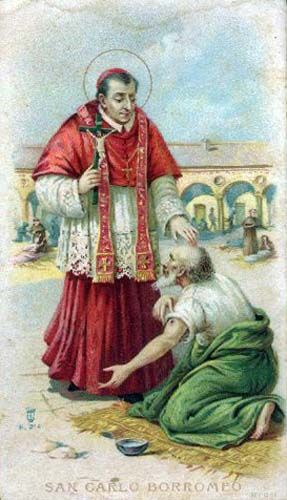Saint Charles Borromeo

Feast day: November 4
Carlo was born on October 2, 1538 in a beautiful castle in Arona on Lake Maggiore in Italy. Already at the age of twelve he became "abbot without obligations" of a monastery on Lake Maggiore. In the past, the nobility could grant themselves sinecures, literally 'without care', that is, lucrative 'offices' that required little work. That gave him a generous income. Soon, however, the boy born in 1538 realized that such a system was wrong and made the money available to the poor. He chose law school and, in addition to being a brilliant head, he was also a Sunday child, for shortly after completing his studies in 1559, his uncle Pope Pius IV ascended to the Pope's throne.
At twenty-four, Carlo became a priest and received episcopal consecration five months later. He issued a modern catechism, persuaded the Pope to resume the Council of Trent, which had been suspended for ten years, visited all the monasteries and parishes of his diocese to introduce a new discipline, preached himself every Sunday, founded orphanages, hospitals and charitable institutions, took the broom through the whole slackened church life. He also founded one of the first seminaries for priests.
He later became Cardinal and Archbishop of Milan. He is one of the leaders of the Catholic Counter-Reformation. In 1566, for example, he published the first Roman catechism. His writings on the ecclesiastical reforms in his diocese of Milan became the model for all those other places where the clergy, monasteries and common people had to carry out the reforms initiated at the Council of Trent.
A monk whose order did not want stricter rules, committed an assassination attempt on Carlo. Many believers also thought he was a sharpener. But that began to change when he went into debt to distribute food during a famine, and he won all hearts when the plague broke out in 1576. The governor and all the governors fled the city; Carlo, on the other hand, obliged every priest, monk and nun to stay in order to assist the plague sufferers and himself set the example day after day. A month after his forty-sixth birthday, his strength left him. Foreshadowing his death, he crawled out of bed at night to die on his stone room floor.
Thanks to him, the shroud of Christ came from the French Chambéry to the Italian city of Turin.
After his death, he was interred in the crypt of the cathedral in Milan. His canonization followed in 1610.
He is patron of the Diocese of Lugano; from the University of Salzburg; of prelates, counselors and seminarians; of the Borromaeus Society and of the Nuns' Congregation of St-Borromaeus.
His intercession is invoked against the plague.
He is depicted as a cardinal (red cloak and flat round cardinal hat); often he is in prayer or handing out communion to plague sufferers.